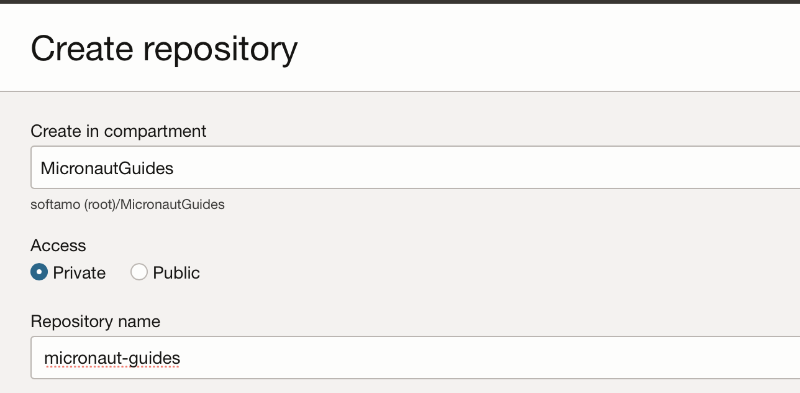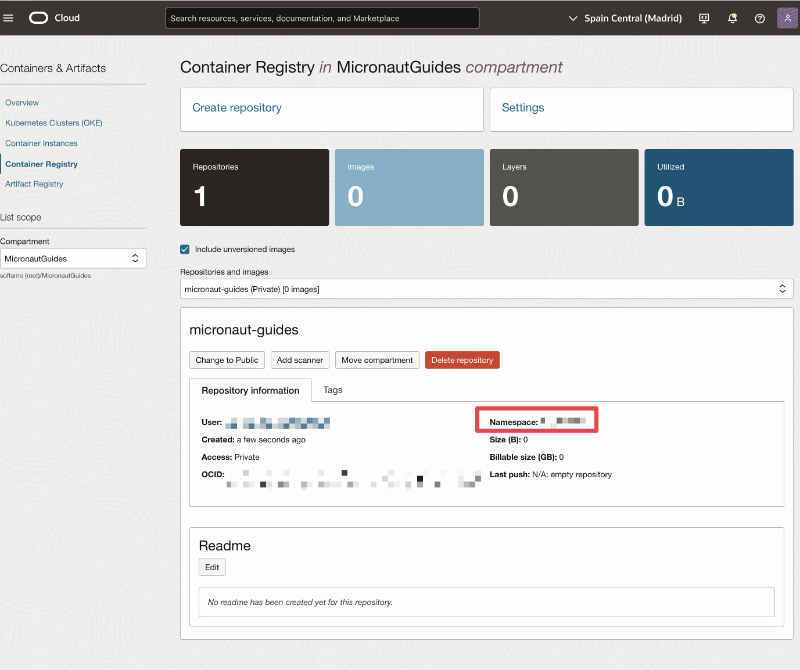mn create-app example.micronaut.micronautguide --build=gradle --lang=javaPush a Docker Image of a Micronaut application to Oracle Cloud Container Registry
Learn how to push a Docker Image of a Micronaut application to Oracle Cloud Container Registry
Authors: Sergio del Amo
Micronaut Version: 4.10.2
1. Getting Started
In this guide, we will create a Micronaut application written in Java.
2. What you will need
To complete this guide, you will need the following:
-
Some time on your hands
-
A decent text editor or IDE (e.g. IntelliJ IDEA)
-
JDK 21 or greater installed with
JAVA_HOMEconfigured appropriately
3. Solution
We recommend that you follow the instructions in the next sections and create the application step by step. However, you can go right to the completed example.
-
Download and unzip the source
4. Writing the Application
Create an application using the Micronaut Command Line Interface or with Micronaut Launch.
If you don’t specify the --build argument, Gradle with the Kotlin DSL is used as the build tool. If you don’t specify the --lang argument, Java is used as the language.If you don’t specify the --test argument, JUnit is used for Java and Kotlin, and Spock is used for Groovy.
|
The previous command creates a Micronaut application with the default package example.micronaut in a directory named micronautguide.
Oracle Cloud Container Registry
In this guide, we push a docker image of a Micronaut Application to Oracle Cloud Container Registry
Create a repository in an OCI compartment.

Annotate the namespace:

5. Auth Token
In the top-right corner of the Console, open the Profile menu, and then select User settings (or My Profile or your account name) to view the details. On the Auth Tokens page, select Generate Token.
Enter a friendly description for the auth token. Avoid entering confidential information.
Select Generate Token. The new auth token is displayed.
Copy the auth token immediately to a secure location from where you can retrieve it later, because you won’t see the auth token again in the Console.
Close the Generate Token dialog.
Micronaut Gradle Plugin
6. Registry Credentials Configuration
Modify the build file and configure the registry credentials using the Docker plugin extension.
The following code samples uses the Gradle Kotlin DSL. You will need to set the environment variable REGISTRY_TOKEN to the auth token you created previously, set the OCI email address, the region and namespace you obtained earlier.
val ociRegion = "eu-madrid-1"
val ociEmail = "email@example.com"
val registryUrl = "ocir.${ociRegion}.oci.oraclecloud.com"
val namespace = "bzcsmyxwoeez"
val image = "${registryUrl}/${namespace}/micronaut-guides"
docker {
registryCredentials {
url.set(registryUrl)
username.set("${namespace}/${ociEmail}")
password.set(System.getenv("REGISTRY_TOKEN"))
}
}7. Docker Image Configuration
Configure the dockerBuild and dockerPush tasks to set the images.
Gradle Groovy DSL
tasks.named("dockerBuild") {
images = [image]
}Gradle Kotlin DSL
tasks.named<DockerBuildImage>("dockerBuild") {
images.set(listOf(image))
}8. Docker Push
You can push to Docker Hub via the dockerPush Gradle Task.
./gradlew dockerPush9. License
| All guides are released with an Apache license 2.0 license for the code and a Creative Commons Attribution 4.0 license for the writing and media (images…). |